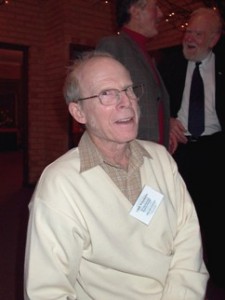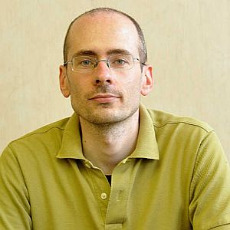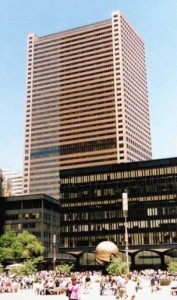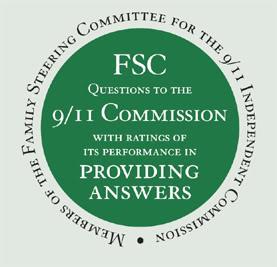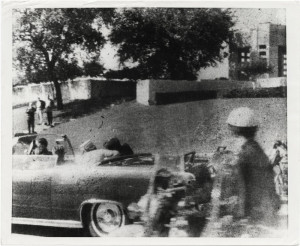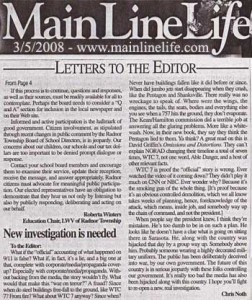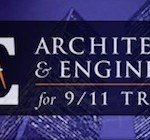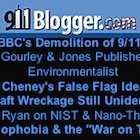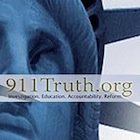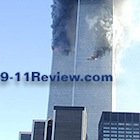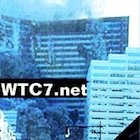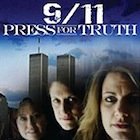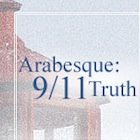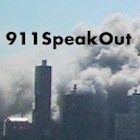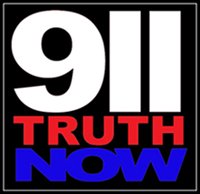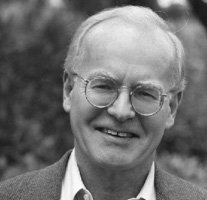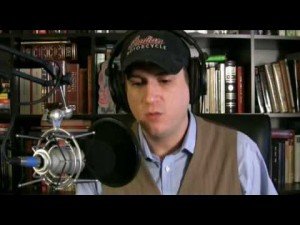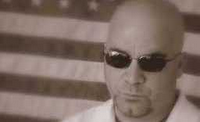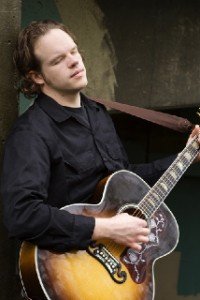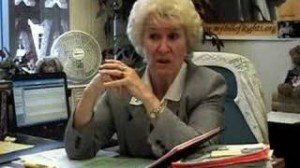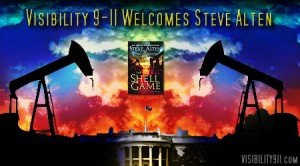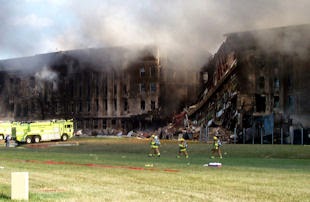
A dozen Army personnel, including many senior officers, went ahead with a routine, previously scheduled meeting at 9:00 a.m. on September 11, 2001, in an area of the Pentagon that was severely damaged when the building was attacked at 9:37 a.m., even though a hijacked plane had crashed into the World Trade Center 14 minutes earlier and this incident had been reported on television since 8:49 a.m. Strangely, the officers were unaware of the crash when they went into their meeting and no one interrupted the meeting to let them know the U.S. was under attack after a second hijacked aircraft hit the World Trade Center at 9:03 a.m. They were consequently still continuing their meeting as if nothing was wrong, oblivious to the crisis that was taking place, when the Pentagon was hit and a huge fireball erupted into their room.
Furthermore, as well as failing to alert the officers in the meeting to what had happened at the World Trade Center, the officers’ colleagues appear to have failed to do anything significant toward implementing a military response to the attacks in New York. Instead, many of them continued their usual duties after learning two aircraft had crashed into the World Trade Center and it became clear that the U.S. was in the middle of a major terrorist attack. Additionally, they appear to have made no attempt to get out of the Pentagon and to somewhere safer, even though the building was a likely target for terrorists.
OFFICERS DISCUSSED ROUTINE ISSUES DURING THEIR MEETING
The 9:00 a.m. meeting was attended by the executive officers for the various directorates and operating agencies of the Army’s Office of the Deputy Chief of Staff for Personnel (ODCSPER). The executive officers’ meeting was held every other Tuesday and usually took place in the ODCSPER conference room, as was the case on September 11. [1]
The ODCSPER “develops Army-wide personnel policies, programs, and systems to facilitate the manning, well-being, and readiness of the Army,” according to author Robert Rossow. Its workforce, comprising 185 military and 90 civilian personnel, had, in June 2001, moved to a new office space on the west side of the Pentagon. This space, on the building’s second floor, had just been renovated and had enhanced safety features, such as emergency-activated smoke doors, water sprinklers, and blast-resistant windows. The space, about an acre in size, comprised mostly of a “bay” of 138 cubicles in which ODCSPER employees worked. It also included the conference room, enclosed offices, and spaces for contractors. [2]
The executive officers’ meeting on September 11 was chaired by Colonel Philip McNair and attended by 11 other Army employees. These included Martha Carden, Lieutenant Colonel Marion Ward, Lieutenant Colonel Marilyn Wills, Lieutenant Colonel Robert Grunewald, Lieutenant Colonel Dennis Johnson, Major Stephen Long, Major Regina Grant, and Lois Stevens. Max Beilke attended the start of the meeting but left early to go to another meeting. There were also two visitors attending–Colonel Larry Thomas and Lieutenant Colonel Curtis Nutbrown–who were there to give a presentation at the end of the meeting. [3]
During the meeting, those attending took turns to give a brief update on recent activities. Matters discussed that day were “routine stuff,” according to authors Patrick Creed and Rick Newman, such as a retirement party and an upcoming conference. [4]
PERSONNEL ONLY LEARNED OF THE CRASH AT THE WORLD TRADE CENTER SHORTLY AFTER 9:00 A.M.
When the 12 Army staffers went into the executive officers’ meeting at 9:00 a.m., they were unaware that a plane had crashed into the World Trade Center, even though American Airlines Flight 11 flew into the North Tower at 8:46 a.m. and the incident had been reported on television since 8:49 a.m. [5]
News of the crash only began to circulate in the cubicle bay outside the conference room shortly after the door closed on the meeting. [6] Around 20 ODCSPER employees started watching CNN’s coverage of the crash on the television in Brigadier General Harry Axson’s office. [7] Others followed the coverage on the television in the cubicle of Marian Serva, a congressional affairs contact officer. [8]
Since the matters discussed at the executive officers’ meeting that day were “routine stuff,” ODCSPER personnel in the cubicle bay should have had no concerns about interrupting a meeting of particular importance. And yet no one went to the conference room to alert the executive officers to what had happened at the World Trade Center. [9]
ODCSPER personnel realized the U.S. was under attack after they saw United Airlines Flight 175 crashing into the South Tower of the World Trade Center live on television at 9:03 a.m. “When the second plane hit, all of us knew this was a terrorist action going on,” Patrick Smith has commented. [10]
Staffers were taking significant notice of what had happened. Antwan Williams has recalled “seeing people in the hallway and at their cubicles talking about what was happening in New York.” [11] “Everyone around me was talking about it,” Lieutenant Colonel Victor Correa described. [12] And yet no one interrupted the executive officers’ meeting to tell its participants that America was under attack.
STAFFERS LEARNED THAT THE ARMY’S CRISIS TEAM HAD BEEN ACTIVATED
The seriousness of the situation should have become even more apparent to ODCSPER personnel when some of them were informed that the Army’s Crisis Action Team (CAT) had been activated. For example, Lieutenant Colonel Michael Beans “heard of the CAT activation” just before Flight 175 crashed into the World Trade Center, according to Robert Rossow. [13] Some time after the second crash occurred, Colonel Karl Knoblauch bumped into Major Linda Herbert and Major Roberta Baynes, and was told by them that Major General Peter Chiarelli, the Army’s director of operations, readiness, and mobilization, “had activated the CAT” and that the two women “had been called down to man their positions.” [14]
Also after the second crash occurred, Lieutenant Colonel Karen Wagner and Major Sherry Sargent heard from the colonel in charge of them that “an emergency operations center was being set up in the basement,” according to Texas Monthly magazine. [15] And Lieutenant Colonel Isabelle Slifer recalled that at around 9:36 a.m., Lieutenant Colonel Reginald Jordan informed her and a few of her colleagues “that the Crisis Action Team had stood up.” [16]
The CAT, according to Rossow, is “an organization of subject matter experts from throughout the Army staff who assemble in times of emergency in a special area within the AOC”–the Army Operations Center in the basement of the Pentagon. [17] Brigadier General Clyde Vaughn, the Army’s deputy director of operations, readiness, and mobilization, described the CAT as “the place that people will migrate” to during an emergency. [18]
And yet, despite learning that the CAT had been activated and, therefore, that the situation must have been considered an emergency, ODCSPER personnel apparently still did not think they needed to interrupt the executive officers’ meeting to alert its participants to what had happened at the World Trade Center.
STAFFERS RECEIVED NO ORDERS FROM THEIR SUPERIORS
Furthermore, Lieutenant General Timothy Maude, the Army’s deputy chief of staff for personnel–the man who ran the ODCSPER–was informed about the first crash at around 9:00 a.m. and then turned on a television to follow what was happening. [19] He should therefore have seen Flight 175 crashing into the World Trade Center at 9:03 a.m. and have then realized that America was under attack. And yet it appears he did not issue any orders to his employees about what they should do in response to the crashes: Sergeant Major Tony Rose recalled that he and his colleagues in the ODCSPER did not receive “any directive or caution” from their “higher command” following the attacks on the World Trade Center. [20] Nor, it appears, did Maude interrupt the executive officers’ meeting, to call on his employees there to assist the Army’s response to the attacks.
Additionally, Nancy McNair–the wife of Philip McNair, the chair of the executive officers’ meeting–phoned Maude’s secretary, Deborah Ramsaur, after seeing the coverage of the crashes on television, to alert her to what had happened. According to Philip McNair, Nancy McNair asked Ramsaur, “Hey Deb, are you watching what’s going on?” Ramsaur wasn’t watching TV and so didn’t know what had happened in New York. Nancy McNair therefore “filled her in.” According to Philip McNair, Ramsaur then asked, “Do you think I ought to go across the hall and tell Phil?” The two women debated whether Ramsaur should interrupt the executive officers’ meeting and pass on the news, but decided against her doing so. “They kind of went back and forth and debated it, and decided not to,” Philip McNair described. “They didn’t have an idea that somebody was gonna hit the Pentagon, necessarily, so they thought they weren’t gonna interrupt the meetings that were going on.” [21] And so another opportunity to alert the executive officers to the crisis was lost.
STAFFERS CONTINUED THEIR USUAL WORK INSTEAD OF INITIATING A MILITARY RESPONSE TO THE ATTACKS
Instead of taking immediate action to implement a military response, ODCSPER employees appear to have initially reacted with alarming indifference to the events of September 11. What is notable is their failure to take appropriate action in response to the attacks in New York.
Most of the individuals who watched the second hijacked plane hitting the World Trade Center on the television in Harry Axson’s office subsequently just returned to their cubicles and some of them then phoned their families. Tony Rose recalled that after they saw the second crash, those in Axson’s office “started filtering out of the office and went back to our cubicle area.” [22] Isabelle Slifer recalled that after watching the second crash, “the majority of us walked out of General Axson’s office back into our cubicles, and I know for a fact that a couple of my colleagues were making phone calls home.” [23] Slifer herself called her husband and told him what had happened in New York. [24]
Strangely, some ODCSPER employees continued their usual, routine work, as if nothing important had happened, after they learned about the second crash and should have realized the U.S. was in the middle of a serious terrorist attack.
For example, Major John Thurman learned about the second crash when someone came into his office and announced what had happened. But instead of joining some of his colleagues and going to watch the coverage of the crashes on TV, Thurman decided to stay at his desk. He did this, he said, because “there were some documents and some work that I wanted to get done.” [25] Linda Herbert heard that two commercial aircraft had hit the World Trade Center when a colleague announced the news. But while her co-workers went to see what had happened on TV, Herbert initially stayed at her desk, since, she recalled, “a pile of paperwork demanded my attention.” A superior officer subsequently persuaded her to go and watch the coverage of the attacks on TV. But after a while, Herbert “decided to return to my desk and finish my work in expectation of new orders.” [26]
Roberta Baynes recalled that after she was told a plane had hit the World Trade Center, she went and “watched TV for a few minutes to see what was happening with the Twin Towers.” But she then told her colleague, Karen Wagner, “I have a lot of work to do; I’m going back to my desk,” and returned to her desk to continue her usual work. [27] Wagner, after seeing the coverage of the crashes on the TV in Harry Axson’s office and being told that “an emergency operations center was being set up in the basement,” looked around the room and said, “Okay, let’s get back to work,” according to Texas Monthly. She then returned to her desk. [28]
Ann Parham saw the second crash on a TV near her cubicle, and heard some of her colleagues commenting “that we were at war and that the Pentagon was at ground zero in that fight.” And yet she then returned to her desk and continued her usual duties. She did this, she said, because she “was leaving that Saturday for a trip home to Georgia and work has a way of beckoning when you’re trying to get out of town.” [29]
Antwan Williams continued putting together and delivering information packets for a forthcoming meeting, even though, he said, upon learning of the second crash, he realized that “something more than an accident” had taken place at the World Trade Center. [30] After watching the television coverage of the crashes for a few minutes, John Yates phoned his wife to see if she knew what had happened and then reportedly “turned to go to a regular morning meeting elsewhere in the building.” [31] And after he saw the second crash on TV, Michael Beans “decided he could do nothing and started back to his office.” [32]
Furthermore, Williams has said that at around 9:30 a.m.–over 25 minutes after the second crash occurred–Deborah Ramsaur was making jokes, even though, by that time, she was presumably aware of the crashes at the World Trade Center. Williams recalled that when he was talking with her, Ramsaur asked him if he would be going to the executive officers’ meeting. He said he couldn’t attend it, because he needed to deliver the information packets for a forthcoming meeting. Williams recalled: “I remember she joked with me and said, ‘It must be nice being a captain and getting to choose which meetings you want to go to.’ And in her typical, playful demeanor she said, ‘Just kidding, I know you are very busy today,’ and gave me her friendly smile.” It seems odd that Ramsaur could have been casually joking with a colleague under such tragic circumstances. [33]
STAFFERS THOUGHT THE PENTAGON MIGHT BE ATTACKED, BUT DID NOT EVACUATE
Some ODCSPER employees thought, after learning of the crashes at the World Trade Center, that the Pentagon could also be the target of a terrorist attack that day and a number of them stated this concern out loud.
Patrick Smith, for example, has commented that he “just had a kind of sinking feeling in my gut that we could be the next target,” after he watched the television coverage of the attacks in New York. [34] He recalled that “there was a thought in the back of his mind that the Pentagon, a major symbol of U.S. military power, could be targeted.” [35] Sometime after the second attack in New York occurred, Major John Jessup told Victor Correa, who was sitting next to him: “You know what happened at the Trade Center? We are just as vulnerable, because we wouldn’t be expecting an attack like that here.” [36]
When Lieutenant Colonel Gregory Fritz entered the office of Colonel Mark Lewis, shortly after 9:30 a.m., he heard someone there who had seen the television coverage of the attacks on the World Trade Center asking, “What’s to stop them from doing the same thing right here at the Pentagon?” [37] And after watching the second crash on TV, Tony Rose told a colleague that they all needed to be “careful” at the Pentagon. [38]
If the Pentagon was a possible terrorist target, as these individuals correctly noted, everyone in the ODCSPER (and those elsewhere in the building) was in danger. And yet no attempt was made to evacuate the ODCSPER and get its employees to somewhere safer before the Pentagon was hit that morning.
Unfortunately, the failure of ODCSPER employees to respond appropriately to the news of the attacks in New York had tragic consequences: Twenty-nine of these employees were killed and 27 were injured in the attack on the Pentagon. Stephen Long and Dennis Johnson, who were in the executive officers’ meeting when the Pentagon was hit, were among those killed. [39]
OFFICERS’ MEETING WAS RUNNING LATE AND SO WAS STILL TAKING PLACE WHEN THE PENTAGON WAS HIT
Curiously, the ODCSPER executive officers’ meeting went on for longer than usual on September 11, which meant it was still taking place when the Pentagon was attacked. The meeting usually lasted “30 minutes or so,” according to Martha Carden, and so it should have ended at around 9:30 a.m. [40] But at 9:36 a.m., one of its participants, Marilyn Wills, looked at her watch and noticed it was running late that day. [41]
A minute later, as Robert Grunewald described, the meeting’s participants heard a “huge explosion” and “a large fireball came into the room.” [42] The Pentagon was hit at 9:37 a.m. The attacking aircraft crashed into the building one floor below the conference room where the executive officers’ meeting was taking place and passed within 20 feet of the room. [43]
Had the meeting ended on time, the executive officers would have learned about the attacks in New York and may have been able to take appropriate action in response to them before the Pentagon was hit. They may have realized their building was a likely target and may therefore have tried to get away from their office space to somewhere safer. But instead, they were unaware of what had happened in New York and that the U.S. was under attack. “We did not know about the World Trade Center. We had no clue,” Martha Carden commented. [44] Consequently, the executive officers had no idea what had caused the explosion and created the fireball that erupted into their room.
SOME STAFFERS THOUGHT THE EXPLOSION AT THE PENTAGON WAS THE RESULT OF AN ACCIDENT
Some of the meeting participants thought there had been an industrial accident when the Pentagon was attacked. “I thought an electrician was working, a gas person was working, a phone company person was working, and severed a line,” Grunewald recalled. [45] “We were in this newly renovated area,” Carden said. “Workmen were still there every day doing stuff. And so many of the people in the conference room thought that, ‘Oh, geez, one of the workers hit a gas line.'” Others thought a bomb had gone off. “I thought that a bomb had probably been detonated outside the conference room, in the E-ring hallway,” Philip McNair said. “My first thought was that it was a bomb,” Carden recalled. [46]
Strangely, some ODCSPER personnel outside the conference room, who knew what had happened at the World Trade Center, thought the explosion they heard when the Pentagon was hit was the result of an accident, even though they should have realized by then that the U.S. was under attack and should therefore have wondered right away if the Pentagon had been hit as part of the attack. Karl Knoblauch, for example, thought that “the explosion might be an industrial accident associated with the renovation” and asked a colleague, “Do they have gas in this building?” [47] Victor Correa recalled, “Since it had been a new construction area, I thought someone hit a gas line and caused an explosion.” [48] And while some of the staffers in Harry Axson’s office were certain that the deafening noise they’d heard “was part of the attack,” others “thought there might have been an explosion at the helipad” outside the Pentagon, according to Texas Monthly. [49]
Other ODCSPER personnel outside the conference room thought the explosion was the result of an attack, but not one involving a plane. Thomas Cleary described: “Until I got outside, I was thinking, ‘How the hell did they get a truck over the railing to get that close?’ I honestly was thinking ‘Oklahoma City’ [referring to the terrorist truck bombing there in 1995]. It didn’t connect in my mind. Two planes have flown [into] the World Trade Center. I didn’t think there was another plane out there.” [50] And Isabelle Slifer thought the Pentagon had been hit by a “chemical missile.” [51] In other words, even though they knew the World Trade Center had just been attacked two times in a row using planes, it apparently did not occur to these individuals that the Pentagon might have been attacked in a similar way. “I had no idea it was a plane,” Cleary commented. [52]
THE ODCSPER’S RESPONSE TO THE 9/11 ATTACKS NEEDS TO BE INVESTIGATED
The evidence detailed above gives rise to serious questions. To begin with, why did ODCSPER employees only learn about the first crash at the World Trade Center shortly after 9:00 a.m., even though the crash occurred at 8:46 a.m. and had been reported on television since 8:49 a.m.? Surely the crash should have been brought to the attention of Army personnel as a matter of urgency, since the military would be responsible for protecting America if it turned out to be part of an attack, as was indeed the case. Even if the crash had been something other than a terrorist attack, the Army may have been needed right away to assist any rescue efforts. Peter Chiarelli stated as much when he talked on the phone that morning to General Eric Shinseki, the Army chief of staff. He said the reason he had activated the Army’s Crisis Action Team was so that it could “respond to the contingency in New York if requested by state and local officials,” since he “anticipated that the World Trade Center disaster would require enormous rescue, firefighting, and recovery efforts.” [53]
Why did ODCSPER employees apparently do little, if anything, toward implementing a military response to the crashes at the World Trade Center prior to the Pentagon being attacked? This was the most important day of their professional lives. Surely they should have been desperate to find out more about what was happening, should have wanted to closely monitor events, and should have wanted to respond immediately to the crisis. And yet many ODCSPER employees continued their usual duties or took the time to phone family members, even after they learned that a second plane had crashed and it should have been obvious to them that the U.S. was in the middle of a major terrorist attack.
Why did ODCSPER employees fail to alert their colleagues in the executive officers’ meeting to what had happened at the World Trade Center? Surely they should have felt it necessary to interrupt the meeting right away, so the executive officers could help the military respond to the attacks. In particular, why did Deborah Ramsaur fail to interrupt the meeting after the wife of its chair called and alerted her to the crashes at the World Trade Center, even though the two women specifically discussed whether she should interrupt it to pass on the news? Surely it should have been obvious to Ramsaur that she needed to interrupt the meeting.
Why did ODCSPER employees stay where they were instead of moving to a safer location after they realized the U.S. was under attack, considering that the Pentagon was a likely terrorist target?
Why did Timothy Maude–the man in charge of the ODCSPER–apparently fail to issue any orders to his employees regarding what they should do in response to the attacks? Surely he should have ordered them to take immediate action after he learned about the crashes at the World Trade Center, and/or he should have been concerned about their security and should therefore have instructed them to move to somewhere safer.
And why did some ODCSPER employees think the explosion at the Pentagon at 9:37 a.m. was the result of an accident? Surely their first thought should have been that it was part of the attack.
These questions need to be addressed as part of a new investigation of 9/11. We can, however, consider possible explanations for why ODCSPER employees acted as they did on September 11 based on the currently available evidence.
WAS THE ARMY RUNNING A TRAINING EXERCISE AT THE PENTAGON ON SEPTEMBER 11?
A possibility worth considering is that when ODCSPER personnel heard about planes crashing into the World Trade Center, they mistakenly thought the crashes were simulated, as part of an Army training exercise taking place at the Pentagon that morning. With this possibility in mind, it is worth noting that on September 11, the Army is known to have been preparing for an exercise based on the scenario of a plane crashing into the World Trade Center. [54]
Peter Chiarelli had decided to hold an exercise for the Army’s Crisis Action Team in the days after September 11. (Chiarelli has implied that the exercise was scheduled to take place on September 17. However, when he interviewed one of Chiarelli’s colleagues, Army historian Stephen Lofgren mentioned that the exercise was going to take place “a couple of days” after September 11, meaning on September 13. [55])
Chiarelli had taken over as the Army’s director of operations, readiness, and mobilization about a month before September 11, and one of his earliest concerns after starting in the position was the CAT, which, he’d learned, had not been significantly exercised for about 10 years. He had therefore decided to run a “no-notice exercise” (an exercise that is conducted without its participants having prior knowledge of when it will occur) for it.
About a week before 9/11, Raymond Robinson Jr., Mark Lewis, and Major Corrina Boggess from the ODCSPER Operations Division briefed Chiarelli on a new mass casualty standard operating procedure (SOP) for the Army that they had been directed to put together. “The real amazing thing of that SOP,” Chiarelli recalled, “is that the scenario was an aircraft crashing into the World Trade Center.” He told Robinson, Lewis, and Boggess, “Hey, not only is this a good SOP and a good plan, but at the same time, to really make this good, what we need to do is exercise it.” Chiarelli recalled that since he “needed a driver for my exercise,” the four of them “decided to integrate a scenario like that into my first CAT exercise.” [56]
Further details of the exercise are unknown. For example, Chiarelli has not revealed what type of aircraft was envisaged hitting the World Trade Center in the scenario, whether the exercise would have involved just one aircraft or more than one aircraft hitting the World Trade Center, or whether the aircraft in the scenario would have been hijacked or would have crashed into the World Trade Center accidentally.
All the same, if the Army was conducting an exercise at the Pentagon on September 11, it could plausibly have been Chiarelli’s exercise, moved forward to take place a few days earlier than originally planned, or it may just have been another exercise.
ACTIONS OF ODCSPER PERSONNEL MAKE SENSE IF STAFFERS THOUGHT THE ATTACKS WERE SIMULATED
If an Army exercise was indeed taking place at the Pentagon on September 11, which included the scenario of planes crashing into the World Trade Center, this might explain why ODCSPER personnel only learned about a plane hitting the World Trade Center at around 9:00 a.m., even though the crash of Flight 11 had been reported on television since 8:49 a.m. The reason for the delay could be that the exercise involved the scenario of a plane crashing into the World Trade Center at 9:00 a.m., whereas the real-world crash took place at 8:46 a.m. What ODCSPER personnel learned about shortly after 9:00 a.m. may in fact have been a simulated plane crash. If this was the case, it could mean that ODCSPER personnel were never told about the actual crash at the World Trade Center.
If the Army was running an exercise at the Pentagon that morning, this could also explain the apparent indifference of some individuals to the crashes at the World Trade Center and could explain why ODCSPER personnel failed to respond to the attacks.
This could be why, instead of promptly responding to the attacks, some ODCSPER employees continued their usual, routine work after they learned of the planes crashing into the World Trade Center. If they thought the crashes were simulated for an exercise, they may have felt it was unnecessary to respond immediately, if at all.
This could be why ODCSPER employees failed to alert the senior personnel in the executive officers’ meeting to the crashes. If ODCSPER employees thought the attacks were real, surely someone would have interrupted the meeting to tell its participants what was happening, so they could start monitoring events and responding to the crisis. But if ODCSPER employees thought the crashes were simulated, they would presumably have been reluctant to disturb a meeting of senior personnel when this may have been unnecessary.
This could be why ODCSPER employees made no attempt to get out of the Pentagon before it was hit, even though the U.S. was under attack and their building, as “a major symbol of U.S. military power,” was a likely target. If they thought the attacks on the World Trade Center were simulated, they would have thought workers at the Pentagon were safe.
This could explain why Deborah Ramsaur was able to joke with Antwan Williams, even though she’d likely just been informed about the planes hitting the World Trade Center. If she thought the crashes were genuine, Ramsaur would surely have been upset and in no mood for jokes. But this would presumably not have been the case if she thought they were part of an exercise.
Incidentally, it is worth keeping in mind that the exercise Peter Chiarelli had been planning was going to involve the Army’s Crisis Action Team. So if ODCSPER personnel were aware of this, when they heard on September 11 that the CAT had been activated, the information may have reinforced the impression that an exercise was taking place.
STAFFERS MUST HAVE THOUGHT THE TV COVERAGE OF THE ATTACKS WAS SIMULATED
For ODCSPER personnel to have thought the crashes at the World Trade Center were a scenario in a training exercise, however, they must have believed the television coverage of the crashes they were watching was simulated. But surely they would have realized it was authentic? Unless, perhaps, they had seen realistic, well-produced simulated TV reports about terrorist attacks in previous exercises and this led them to mistake the genuine reports on September 11 for simulated reports.
Another possibility is that the video ODCSPER personnel were watching on September 11 was simulated television coverage, which had been created for an exercise, to make it feel more realistic. This simulated television coverage might, for example, have been created for Peter Chiarelli’s exercise, which is known to have included the scenario of a plane crashing into the World Trade Center. If ODCSPER personnel were indeed watching simulated television coverage, they may have been able to tell that it was artificial and this realization could have reinforced any belief they had that the attacks on the World Trade Center were part of an exercise.
Furthermore, if ODCSPER personnel were watching television coverage that was simulated, this might explain the curious descriptions some of them have given of what they saw on TV. Isabelle Slifer, for example, described the coverage of the second plane hitting the World Trade Center as “a surreal and almost movie-like production.” [57] Gregory Fritz reportedly “thought what he had seen must be a movie promotion, until informed of what had been happening,” after he saw the second crash on TV. [58]
And if ODCSPER personnel were watching simulated television coverage, this might explain the reaction to the crashes described by Tony Rose. Rose was watching the TV in Harry Axson’s office, along with about 17 of his colleagues. In response to what they saw, he recalled: “Most people were saying, ‘I can’t believe this!’ ‘This can’t be real.’ ‘Are you sure this is really happening?'” “None of us could believe it,” he commented. [59]
Curiously, it appears that no one from the ODCSPER has mentioned seeing President Bush delivering his speech from the Emma E. Booker Elementary School in Sarasota, Florida, in which he declared, “Two airplanes have crashed into the World Trade Center in an apparent terrorist attack on our country,” even though this speech was shown live on CNN, CBS, ABC, NBC, and Fox at 9:30 a.m. on September 11, when many ODCSPER employees were presumably still watching TV. [60] Is this because ODCSPER employees have simply failed to mention seeing this speech when interviewed about their experiences on September 11? Or is it because they were watching simulated television coverage that morning, and this simulated coverage did not include Bush giving his speech?
INVESTIGATORS NEED TO FIND OUT ABOUT ANY ARMY EXERCISES ON SEPTEMBER 11
If the Army was indeed running a training exercise at the Pentagon on the morning of September 11, this gives rise to other important questions, especially if the exercise included the scenario of planes crashing into the World Trade Center.
For example, what specifically did the exercise involve? Who exactly came up with the idea for it? Which specific individuals planned it and who was running it on September 11? And why wasn’t it called off after 8:46 a.m., when a plane actually did crash into the World Trade Center?
Additionally, is it just a coincidence that an exercise based around the scenario of planes crashing into the World Trade Center was being conducted at the same time as planes really did crash into the World Trade Center or is there a more sinister explanation for this concurrence of events? Might the exercise have been intended to prevent honest and dedicated Army personnel from effectively responding to the 9/11 attacks, by causing them to mistake actual events for part of an exercise? If so, this would indicate that rogue individuals in the U.S. military were involved in creating the deception.
Clearly we need a rigorous and unrestrained new investigation of 9/11 to address these questions, and find out exactly what happened at the Pentagon on September 11.
NOTES
[1] Robert Rossow III, Uncommon Strength: The Story of the U.S. Army Office of the Deputy Chief of Staff for Personnel During the Attack on the Pentagon, 11 September 2001. Washington, DC: Department of the Army, Office of the Deputy Chief of Staff, 2003, p. 39; Stephen J. Lofgren (Editor), Then Came the Fire: Personal Accounts From the Pentagon, 11 September 2001. Washington, DC: Center of Military History, United States Army, 2011, p. 137.
[2] Robert Rossow III, Uncommon Strength, pp. iv, viii-ix; Linda Herbert, “The Day I’ll Never Forget.” Today’s Christian Woman, September/October 2004; Alfred Goldberg et al., Pentagon 9/11. Washington, DC: Historical Office, Office of the Secretary of Defense, 2007, p. 36.
[3] Robert Rossow III, Uncommon Strength, p. 39; Stephen J. Lofgren (Editor), Then Came the Fire, pp. 137-138.
[4] Patrick Creed and Rick Newman, Firefight: Inside the Battle to Save the Pentagon on 9/11. New York: Presidio Press, 2008, p. 18.
[5] “8:48 a.m.-9:29 a.m.” CNN, September 11, 2001; Alfred Goldberg et al., Pentagon 9/11, pp. 40-41; Patrick Creed and Rick Newman, Firefight, p. 19.
[6] Robert Rossow III, Uncommon Strength, p. 35.
[7] Stephen J. Lofgren (Editor), Then Came the Fire, pp. 135, 162; John Spong, “Karen Wagner’s Life.” Texas Monthly, September 2011.
[8] Earl Swift, “Out of Nowhere: Inside the Pentagon on 9/11.” Virginian-Pilot, September 7, 2002; Robert Rossow III, Uncommon Strength, p. 21.
[9] Patrick Creed and Rick Newman, Firefight, pp. 18-19.
[10] John J. Kruzel, “Survivor Recalls Memories of Pentagon Attack.” American Forces Press Service, September 2, 2008.
[11] Antwan C. Williams, “10 Years of Memories: ARSOUTH Officer Recalls Tragic Day for First Time Since Attack.” United States Army South, October 7, 2011.
[12] Dean E. Murphy, September 11: An Oral History. New York: Doubleday, 2002, p. 230.
[13] Robert Rossow III, Uncommon Strength, p. 33.
[14] Ibid. p. 51; Linda Herbert, “The Day I’ll Never Forget.”
[15] John Spong, “Karen Wagner’s Life.”
[16] Kathryn Roe Coker, David T. Zabecki, and Deborah Foster-King (Editors), The Role of the Army Reserve in the 11 September Attacks: The Pentagon. Fort McPherson, GA: Office of Army Reserve History, 2003, p. 3.
[17] Robert Rossow III, Uncommon Strength, p. 64.
[18] Clyde Vaughn, interview by Stephen Lofgren. U.S. Army Center of Military History, February 12, 2002.
[19] Robert Rossow III, Uncommon Strength, p. 51.
[20] Stephen J. Lofgren (Editor), Then Came the Fire, pp. 162-163.
[21] “Remembering 9/11: Reflecting on the Day When Heroes Stood up Against Terror.” American Military University, September 7, 2011.
[22] Stephen J. Lofgren (Editor), Then Came the Fire, p. 162.
[23] Ibid. pp. 135-136.
[24] “Isabelle Slifer Shares Her Story.” National 9/11 Pentagon Memorial, n.d.
[25] United States of America v. Zacarias Moussaoui. United States District Court for the Eastern District of Virginia, Alexandria Division, April 11, 2006.
[26] Linda Herbert, “The Day I’ll Never Forget.”
[27] Bernard W. Tate, “Pentagon Survivors Tell Their Stories.” U.S. Army, September 14, 2011.
[28] John Spong, “Karen Wagner’s Life.”
[29] “Myrtis Ann Parham.” Los Angeles Times, September 11, 2002.
[30] Antwan C. Williams, “10 Years of Memories.”
[31] Laura Moyer, “‘We Can Never Forget.'” Fredericksburg Free Lance-Star, September 10, 2006; Stephen J. Lofgren (Editor), Then Came the Fire, p. 171.
[32] Robert Rossow III, Uncommon Strength, p. 33.
[33] Antwan C. Williams, “10 Years of Memories.”
[34] Richard T. Cooper, “Outside Pentagon, a Defenseless Feeling.” Los Angeles Times, September 12, 2001.
[35] Andrew Gray, “Pentagon Sept. 11 Memorial Revives Painful Memories.” Reuters, September 10, 2008.
[36] Dean E. Murphy, September 11: An Oral History, p. 230; “Frozen in Memory, the First Moments of a Transformed World.” New York Times, September 11, 2002.
[37] Robert Rossow III, Uncommon Strength, p. 21.
[38] Stephen J. Lofgren (Editor), Then Came the Fire, pp. 162-163.
[39] Robert Rossow III, Uncommon Strength, p. 129; Alfred Goldberg et al., Pentagon 9/11, pp. 42-43.
[40] Stephen J. Lofgren (Editor), Then Came the Fire, p. 145.
[41] Robert Rossow III, Uncommon Strength, pp. 39-40; Patrick Creed and Rick Newman, Firefight, pp. 18-19.
[42] “A 9/11 Pentagon Survivor Remembers and Mourns.” Metro Connection, WAMU, September 9, 2011.
[43] Steve Vogel, The Pentagon: A History. New York: Random House, 2007, p. 436.
[44] Stephen J. Lofgren (Editor), Then Came the Fire, p. 148.
[45] “A 9/11 Pentagon Survivor Remembers and Mourns.”
[46] Stephen J. Lofgren (Editor), Then Came the Fire, pp. 138, 148.
[47] Robert Rossow III, Uncommon Strength, p. 54.
[48] “Frozen in Memory, the First Moments of a Transformed World.”
[49] John Spong, “Karen Wagner’s Life.”
[50] Stephen J. Lofgren (Editor), Then Came the Fire, p. 66.
[51] Kathryn Roe Coker, David T. Zabecki, and Deborah Foster-King (Editors), The Role of the Army Reserve in the 11 September Attacks: The Pentagon, p. 4.
[52] Stephen J. Lofgren (Editor), Then Came the Fire, p. 66.
[53] Alfred Goldberg et al., Pentagon 9/11, p. 134.
[54] See “Army Command Center at the Pentagon Planned to Hold Exercise in Week After 9/11 Based on a Plane Hitting the WTC.” Shoestring 9/11, March 26, 2011.
[55] Pete Chiarelli, interview by Frank Shirer. U.S. Army Center of Military History, February 5, 2002; Clyde Vaughn, interview by Stephen Lofgren.
[56] Pete Chiarelli, interview by Frank Shirer; Robert Rossow III, Uncommon Strength, pp. 64-65; Stephen J. Lofgren (Editor), Then Came the Fire, pp. 95-97.
[57] Stephen J. Lofgren (Editor), Then Came the Fire, p. 135.
[58] Robert Rossow III, Uncommon Strength, p. 21.
[59] Stephen J. Lofgren (Editor), Then Came the Fire, p. 162.
[60] “9:12 a.m.-9:54 a.m.” ABC News, September 11, 2001; “9:12 a.m.-9:54 a.m.” CBS News, September 11, 2001; “9:12 a.m.-9:54 a.m.” Fox News, September 11, 2001; “9:12 a.m.-9:54 a.m.” NBC News, September 11, 2001; “9:29 a.m.-10:11 a.m.” CNN, September 11, 2001.
